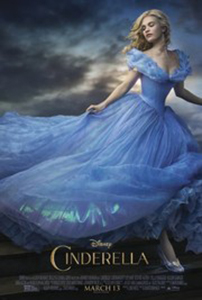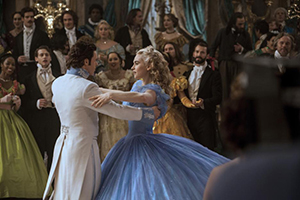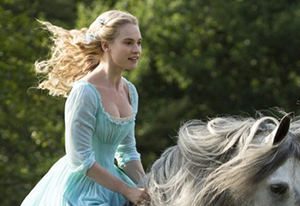It’s hard to find any aspects of this age-old story that haven’t been analyzed to death. One could go on about how backwards it is when looking at it from a feminist’s perspective, or about how Cinderella is a terrible role model for young girls. I could flex my critical muscles by writing academically about the film’s intertextual relations (though who would read that?). No, this seems like an opportunity to explain why Disney’s version of the Hollywood storytelling formula works so dang well, and why we can’t seem to get enough of it.
The word “formula,” in this case, should not carry a negative connotation. The Disney formula, like Hollywood’s, has been time-tested to perfection; it simply wouldn’t be as culturally significant otherwise. Not since the animated “Cinderella” of 1950 does a Disney movie exemplify that formula better than this new live-action iteration. The elegance and effectiveness of that formula’s simplicity is that a pure of heart protagonist, whose identity is largely defined as being part of a family, is somehow separated from her family and forced to redefine who she is as an individual. Once she successfully redefines who she is, she is able to create/join a new family with which to live happily ever after. (Zach Baker articulates this same basic formula very well) This blueprint can be found in any number of Disney movies, from “Snow White” to “The Lion King.” But what really sells Disney’s version of “Cinderella” as the quintessence of its brand is a special additional element: the fulfillment of the American Dream.
“Pinocchio” (1940) was actually the first Disney film to sell the idea of wish fulfillment. However, in that tale this idea was still too abstract. The rags-to-riches dynamic in “Cinderella” is what helps distinguish it as being certifiably American. The irony of course being that such a dream is hardly unique to Americans. While Pinocchio achieves his dream of becoming a real boy, Cinderella is able to climb the economic ladder from destitution to opulence. The former is effectively a stand-in for an immigrant adapting to become an American, and the latter is a parable for what’s hoped for once this is so.
Strictly speaking, Cinderella’s eventual monetary wealth is meant to symbolize a wealth of happiness in general. She was least happy when she was treated as a servant with an estranged spiteful “family,” and ecstatic once she found herself in love and in a position to create a new family. The hateful step mother and step sisters represent the darker motivations behind the American Dream (e.g. greed and social status), which is why they ultimately find themselves unfulfilled. Nevertheless, a positive correlation between affluence and happiness is made, reaffirming our desire for economic prosperity.
So how does the new “Cinderella” articulate this conception so well? The answer begins and ends with its impressive displays of literal, figurative, and visual magic. The special effects themselves are merely passable and not really worthy of description. But the overall style of the film conveys a grandiosity in its themes that has not been captured in any previous adaptation. From the golden carriage to the palace grounds to Cinderella’s resplendent blue ball gown, director Kenneth Branagh seems to spare no expense to imply a link between the magical and the ostentatious. For us to observe such literal and figurative prosperity simultaneously is to find ourselves living the very same fairy tale as our heroine. And that is the type of wish fulfillment that Disney is deft at providing.
Whether male or female, poor or rich, Cinderella’s fate represents the gratification that comes with collecting the pot of gold at the end of the rainbow. The fact that it’s unattainable in real life is immaterial. Through a film like “Cinderella” we can vicariously experience the ascension from who we are to who we wish we could be. Believing (if only for 90 minutes) the magic and the possibility it could be real.
The narrative formula for expressing this fulfillment is simple because our aspiration is simple; if carried out correctly that formula can exceed even its own expectations. This newest “Cinderella” comes close to doing just that. In making such films, Disney and Hollywood prove to be a pairing that is very difficult to match. It says a lot about any one filmmaker, let alone an entire brand, who finds a way to blend artistic form with creative purpose. With Branagh’s help, Disney adds another successful example to its legacy. The American Dream isn’t going to fade into history anytime soon, which is why we will continue to eagerly consume all of Disney’s future illustrations of it.






Leave a Reply
You must be logged in to post a comment.